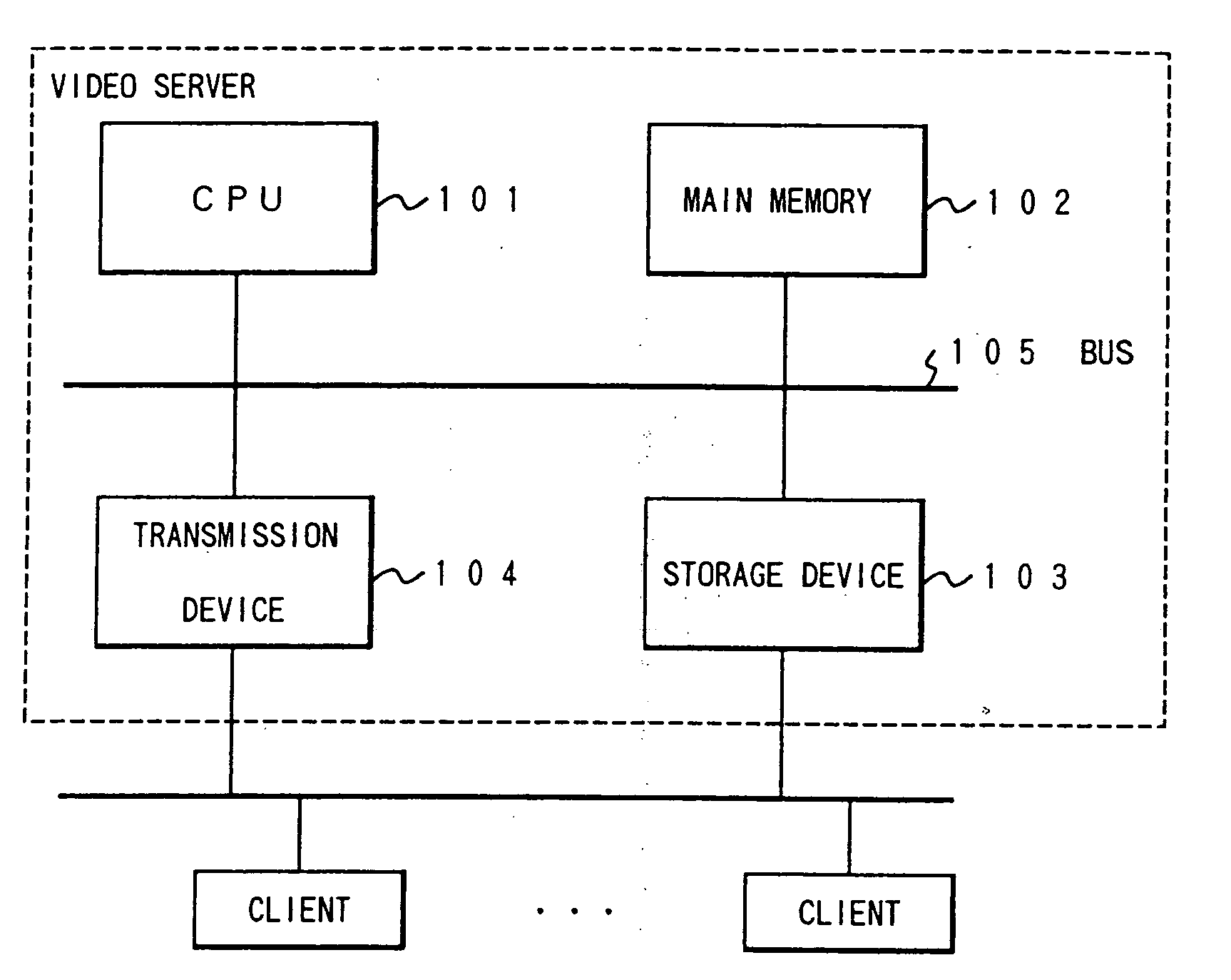Multimedia data processing system in network
a multi-media data and network technology, applied in the field of information processing systems, can solve the problems of data amount exceeding large, transmission time, data compression processing, etc., and achieve the effect of high data output speed
- Summary
- Abstract
- Description
- Claims
- Application Information
AI Technical Summary
Benefits of technology
Problems solved by technology
Method used
Image
Examples
first embodiment
[0197] First, a first embodiment according to the present invention will be described. In the following description, sound-attached moving-picture data are assumed to sound-attached moving-picture data of MPEG1 format.
[0198]FIG. 1 is a block diagram showing the construction of a video server to which a first embodiment is applied. As shown in FIG. 1, a video server comprises a CPU 101, a main memory 102, a storage device 103, a transmission device 104 and a bus 105.
[0199] In this embodiment, the following sound-attached moving-picture (video) data forming processing is performed. That is, on the basis of original sound-attached moving-picture data of MPEG1 format which are stored in the storage device 103, MPEG1-format sound-attached moving-picture data of a desired reproduction time which has a data amount smaller than the original sound-attached moving-picture data and are suitable to output corresponding moving pictures and sounds (which are associated with each other) at the s...
second embodiment
[0244] Next, a second embodiment of the present invention will be described.
[0245] In the second embodiment, the following reduction processing 304 is used in place of the reduction processing 302. The reduction processing 304 will be described hereunder in detail with reference to FIGS. 13 and 14.
[0246]FIG. 14 is a flowchart showing the process flow of the reduction processing 304. In the reduction processing 304, the moving-picture data stored in the file 202 are first scanned until the start code of the picture 603 is detected, and portions other than the picture 603 are extracted and stored in the file 204 as shown in FIG. 14 (step 1401).
[0247] Subsequently, on the basis of the picture type of the picture 603 detected in step 1401, it is judged whether the picture 603 is a B-picture (step 1402). If the picture is the B-picture, dummy data shown in FIG. 13 are stored in place of the data constituting the B-picture (step 1403).
[0248]FIG. 13 shows the data structure of the dumm...
third embodiment
[0254]FIG. 15 is a schematic diagram showing the construction of a third embodiment according to the present invention. As shown in FIG. 15, a system of the third embodiment includes a server 2101, networks 2102 and 2104, a multimedia data amount control relay device 2103 and a client 2105. That is, the server 2101 is connected through the network 2102 to the multimedia data amount control relay device 2103, and the client 2105 is connected through the network 2104 to the multimedia data amount control relay device 2103. Multimedia data are communicated between the server 2101 and the client 2105, and at this time the multimedia data amount control relay device 2103 controls the data amount.
[0255] The server 2101 may supply services to clients other than the client 2105, however, only the client 2105 is illustrated in FIG. 15 in order to simplify the description of this embodiment. When the system is designed so that the transmission capability is different between the network 2102...
PUM
 Login to View More
Login to View More Abstract
Description
Claims
Application Information
 Login to View More
Login to View More - R&D
- Intellectual Property
- Life Sciences
- Materials
- Tech Scout
- Unparalleled Data Quality
- Higher Quality Content
- 60% Fewer Hallucinations
Browse by: Latest US Patents, China's latest patents, Technical Efficacy Thesaurus, Application Domain, Technology Topic, Popular Technical Reports.
© 2025 PatSnap. All rights reserved.Legal|Privacy policy|Modern Slavery Act Transparency Statement|Sitemap|About US| Contact US: help@patsnap.com



